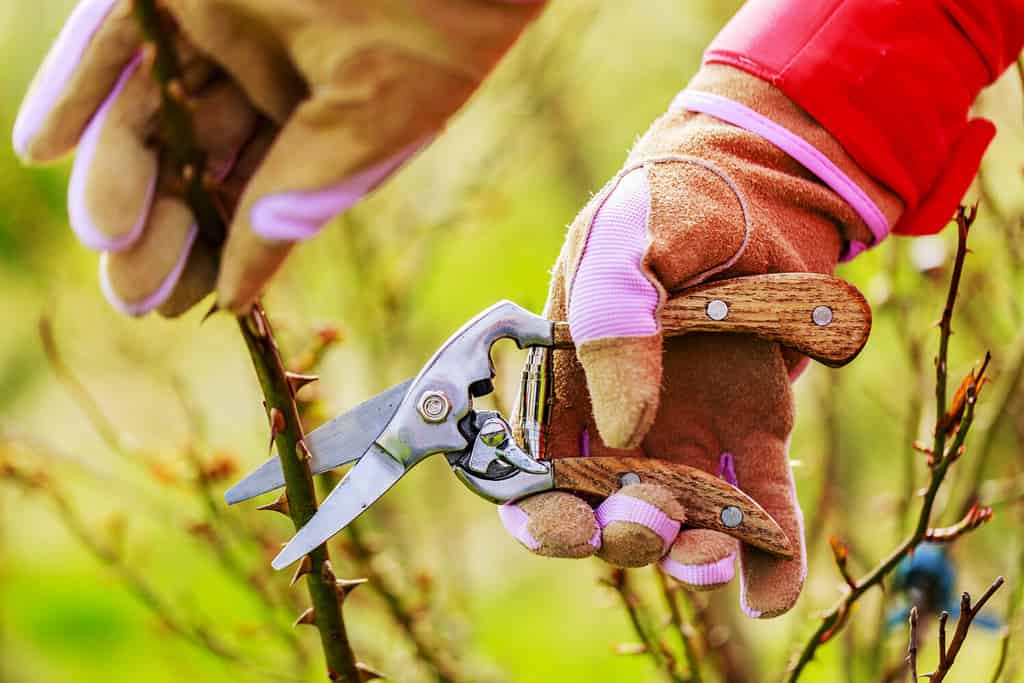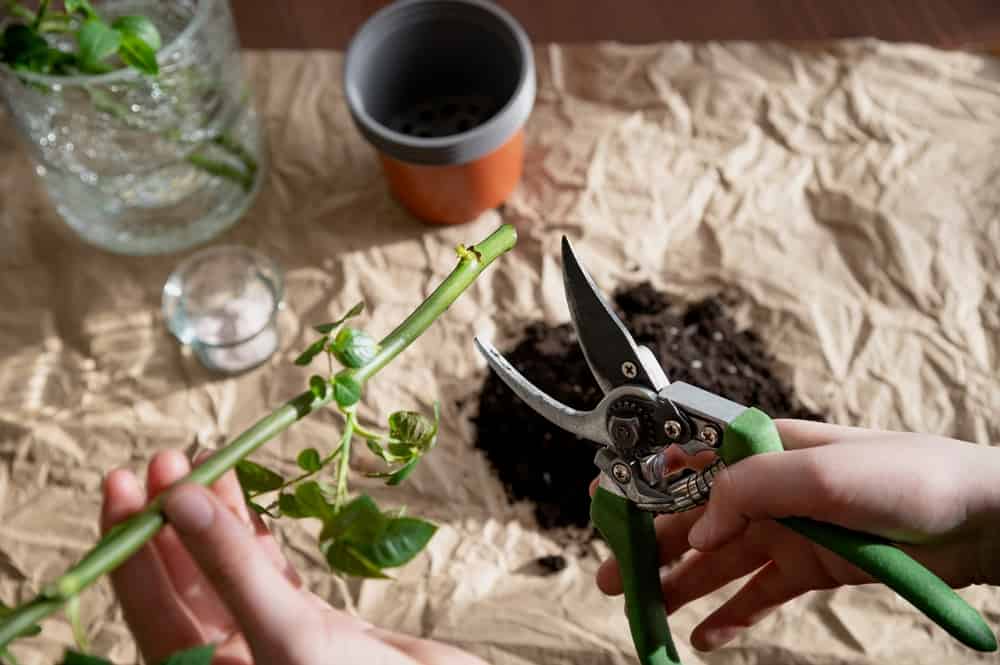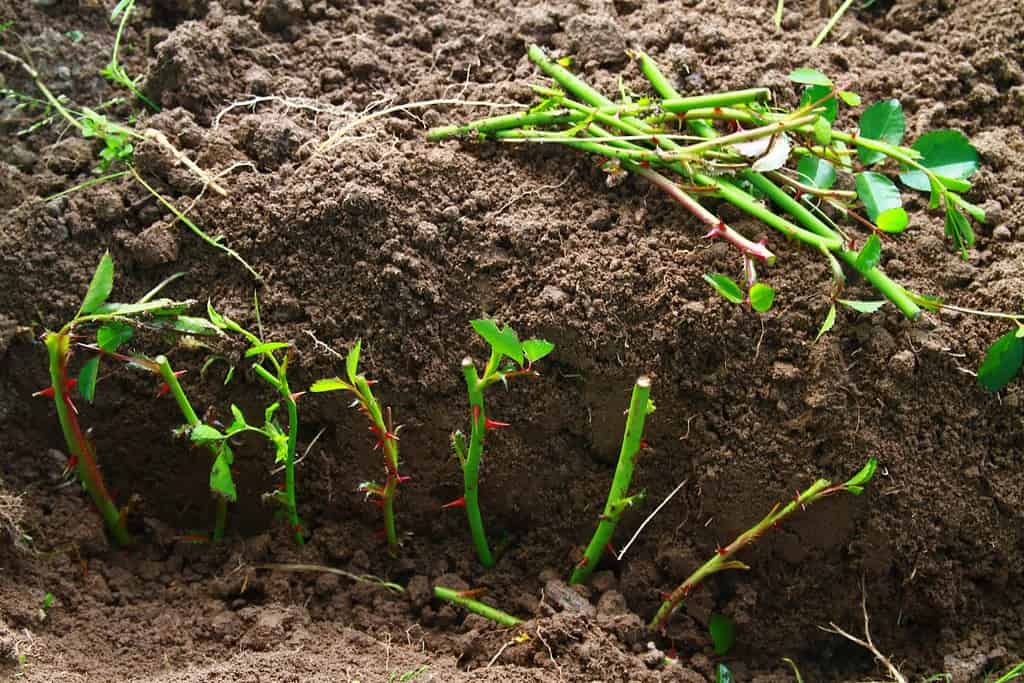The majority of rose species and varieties out there are straightforward to grow and simple to propagate at home, despite their reputation for being picky. To propagate simply means to quickly and easily create new plants from a single cutting of an existing plant. Rooted cuttings create identical plants as opposed to seeds, which yield vastly varied plants. To replicate beloved family heirlooms or favorite garden roses, you don’t need to have any formal training in rose culture. This guide can help!
In this article, we’ll break down how to propagate your own roses via cuttings. The process is much simpler than you might think.
Why Cuttings Instead of Seeds?

Cutting roses produces a perfect clone of the parent plant.
©Gonzalo de Miceu/Shutterstock.com
Because it has various benefits over growing roses from seed, roses are often reproduced by cuttings rather than from seed. The ability to grow roses from cuttings gives gardeners and rose aficionados a method to conserve and spread their favorite rose varieties.
Cutting roses generates a perfect clone of the parent plant, which is one of the method’s key benefits. This implies that the young plant will bear flowers that are identical to the original plant in terms of color, shape, and aroma. The population of roses produced by roses grown from seed, on the other hand, is varied and may not all resemble the parent plant. This is due to the genetic diversity of roses, like many other plants, and the possibility that seeds from one plant may include genetic material distinct from that of the parent plant.
The Many Benefits of Growing Roses From Cuttings

Beautiful rose bushes (pictured) can be created by cutting propagation over seeds.
©Gonzalo de Miceu/Shutterstock.com
Growing roses from seed takes significantly longer to create a mature plant than rose cutting propagation, which is another benefit. Rose cuttings may root and produce a full plant in one to two years as opposed to rose seeds, which can take up to six weeks to germinate and several years to reach maturity. This is crucial for gardeners who wish to reproduce a lot of roses for a landscaping project or quickly replace a beloved rose variety that has reached the end of its life cycle.
Propagating roses through cuttings only requires a few simple pieces of equipment and supplies. In the spring or summer, gardeners can take a stem cutting from a healthy rose plant, soak the cut end in rooting hormone, and then plant it in a container or directly into the ground. Within a few weeks, with the right care, the cutting will form roots and start to grow. We’ll get more into the process later on in this guide.
When to Propagate Rose Cuttings

Roses go dormant in early winter.
Image: Vladimir Martinov, Shutterstock
©Vladimir Martinov/Shutterstock.com
The dormant season occurs in late autumn or early winter after the plant has had a strong cold. This is when rose cuttings are commonly propagated. This is so that cuttings may be taken without seriously harming the parent plant as the plant is not actively developing at this time.
Rose cuttings can also be taken in warmer areas in the early spring or summer following the first burst of growth. However, because the parent plant is actively developing and may be more susceptible to injury during these seasons, cuttings must be taken with extra caution and care.
Once the propagation process is complete, the cutting should root and begin to develop within a few weeks with the right care and attention. It may either be put straight into the ground or into a larger container once it has established a robust root system.
Gather and Prep Your Tools

Sharp pruners and gloves are needed when cutting roses.
©gorillaimages/Shutterstock.com
When cutting roses, sharp pruners are required. The rose’s woody stems can be crushed by dull instruments rather than sliced cleanly, which increases the risk of fungal rot. In order to prevent the spread of any infections, be sure to clean your pruners both before and after each cutting with some rubbing alcohol.
The supplies you will need include the following:
- Clean pruning shears
- An established rose plant
- Rooting hormone
- Rose potting soil or a mix of sand and vermiculite with potting soil
- A suitably-sized pot
- Cling wrap
Prepare The Space When Your Roses Will Grow

Softwood cuttings can be planted in deep trays, pots, or into the ground.
Image: Mariia Boiko, Shutterstock
©Mariia Boiko/Shutterstock.com
Softwood cuttings allow for some freedom in how and where they are placed for germination and growth. However, you should plant cuttings as soon as possible after taking them, so prepare your location beforehand. Softwood cuttings can either be planted in deep trays, pots, or directly into a prepared section of your outdoor garden space.
To plant in a garden, pick a location that receives bright, indirect light so that cuttings won’t be affected by excessive heat or sun. The best rooting locations are in the north and east. To make the soil in your new propagation bed crumble readily, cultivate it to a depth of four to six inches. If your soil is dense, mix in a little quantity of sand to make it easier for new roots to grow.
Plant your cuttings at least six inches deep in a tray or container to give the young roots plenty of time to develop. It is effective to mix coarse sand and perlite or vermiculite in equal proportions as soil, though you can buy premixed rose soil at your local garden store. When you’re finished, thoroughly water the soil mixture.
How to Propagate Roses From Cuttings
Cutting-based rose propagation is a fun and economical approach to growing your favorite rose varieties. It’s a straightforward procedure that entails taking a healthy rose plant stem cutting and helping it to establish roots and grow into a new plant. The following are the detailed directions for growing roses from cuttings.
1. Choose a Good Stem
Selecting a healthy stem from a parent plant is the first stage in the cutting-based rose propagation process. Choose a stem with a diameter of about a quarter inch that is straight and strong. Make sure that the stem is devoid of any blooms or buds and shows no symptoms of illness or pests. Pick a stem with at least two pairs of leaves and a length of six inches or more.
2. Remove Most of the Leaves

Most leaves should be removed so the cutting can focus on producing roots.
©Evtushkova Olga/Shutterstock.com
Just the top two pairs of leaves on the stem should be left. Then, just above this top set of leaves, cut off the remaining piece of the stem. The cutting will be able to focus its efforts on producing roots if the extra leaves are taken off. By doing this, water loss will also be decreased and withering of the cutting will be avoided.
3. Cut Off and Collect Your Cutting

Take a healthy cut from an existing rose bush using a pair of sterilized pruning shears.
©PhotoJuli86/Shutterstock.com
It is now time to take a cut from the healthy stem you have chosen. Make a clean cut at a 45-degree angle, about a quarter inch below the node, using a pair of sharp, sterilized pruning shears. A node is a place on a stem where the leaves or buds are connected. It should be easy to spot.
4. Prepare Your Cutting

Prepping of a rose cutting is necessary to grow new roses.
©Kokhan O/Shutterstock.com
Dip the end of the stem that has been chopped off into a rooting hormone (which is usually available in a powder form) to boost your chances of success. Plant hormones found in rooting hormone aid in promoting root development.
5. Plant Your Cutting
The clipping should then be planted after it has been dipped in the rooting hormone. A well-draining rooting media, such as perlite or sand, should be added to the container. With the aid of a pencil or dowel, carefully insert the cutting into the hole you have made in the middle of the soil. Ensure that the remaining leaves are above the surface and that the cutting is placed into the soil between one and two inches deep.
6. Spray and Cover Your Propagated Rose Plant
Water the cutting well after planting it. The rooting media has to be damp but not soggy. Use a clear plastic bag or plastic wrap to completely enclose the container to help retain moisture by simulating a mini-greenhouse. This will promote roots and keep the surrounding area’s humidity levels high.
Make sure the plastic does not come into contact with any of the stem’s surviving leaves, as this might leave them damp and vulnerable to fungus. To keep the plastic away from the foliage, insert a long stake inside the pot. Additionally, the bag has to have a little opening so humidity may escape. If the bag is sealed too tightly, the stem may rot. Put the watered and covered cutting next to a bright window or beneath grow lights.
7. Create the Ideal Atmosphere

Find a good spot for your rose cuttings in indirect sunlight.
©P. OCHASANOND/Shutterstock.com
Put the container in an area that is cozy, bright, and gets a lot of indirect sunshine. The cutting might dry out or overheat if the container is placed in direct sunlight. If you don’t have a window with natural light, you may put the pot under a grow lamp. Maintain a wet but not soggy rooting media. To prevent wilting, check the cutting frequently, and cut off any dead leaves or stems.
8. Be Patient!
You should start to see roots appear after a few weeks. Check for fresh growth or give the stem a little pull to see if it resists. If you feel any resistance, the cutting probably has grown roots. If it doesn’t have much give and feels like it will easily slide out, it is not ready. Once it is ready, you can take off the plastic wrap or bag and let the cutting adjust to the decreased humidity conditions. Water the cutting as usual, but less often to prevent overwatering.
9. Plant Your Propagated Rose

Rose cuttings can be planted in the ground or in a container.
©Evtushkova Olga/Shutterstock.com
The cutting should be planted into a bigger container or directly into the ground once it has grown a robust root system. Make sure the planting hole is deep enough to support the root system. Select organically rich, well-draining soil. After transplanting, give the plant plenty of water. As it grows and becomes established, continue to give it water as needed.
Congratulations! You know have a propagated rose plant. From here on out, simply care for your propagated rose the way you would care for any other rose.
FAQs About Growing Roses From Cuttings
Is There a Difference Between Softwood, Hardwood, and Semi-Hardwood Roses?
Yes. Cuttings from young growth that is still malleable and hasn’t yet hardened off are known as softwoods. These cuttings are normally made when the plant is actively developing, which is often in late spring or early summer. Softwood cuttings are frequently used for plants that are challenging to reproduce in other ways because they can root fast. Softwood cuttings are an effective method of rose propagation.
Hardwood cuttings are obtained from more mature, older growth that has hardened off. These cuttings are normally made while the plant is dormant, which is typically in late fall or early winter. Despite taking longer than softwood cuttings to establish root, hardwood cuttings are often more dependable and have a greater success rate.
Semi-hardwood cuttings are often obtained in the middle to end of the summer from growth that has partially hardened off. While not as mature as hardwood cuttings, these cuttings are better developed than softwood cuttings.
Can All Roses Be Propagated Via Cuttings?
Cuttings may be used to reproduce the majority of rose varieties. However, certain cultivars are easier to root than others. Although climbers, shrubs, and old garden roses can also be grown by cuttings, hybrid teas and floribundas are among the rose varieties that are most frequently propagated.

Floribundas (pictured) and hybrid tea roses are propagated by cuttings quite often.
©iStock.com/Rolleen Annie and Rowena Ho K.
How Can Roses Root Quickly From Cuttings?
Be careful to select a cutting from new growth that has completed flowering if you want to reproduce your roses fast. Apply rooting hormone to the end of the cutting to promote the growth of a root system.
Is Rooting Hormone Necessary for Rose Propagation?
When growing rose cuttings, using rooting hormone will likely improve your results. Plant hormones found in rooting hormone aid in promoting root development. It is not necessary, though, and some gardeners have succeeded without it.
Can Roses Root in Just Water?

It is possible to root roses in water.
©Jurga Jot/Shutterstock.com
Although soil usually results in roots that are stronger, it is possible to root roses in water. The cutting should be handled just as though it were going to be rooted in soil. Put it about halfway into a container of water, then put it in a window or near grow lights. At least twice a week, change the water.
How Do I Care For My Rose Once It Has Rooted?
It’s crucial to gradually acclimatize your rose cuttings to reduced humidity levels once they have taken root. In order to avoid overwatering, minimize the frequency with which you water the cutting after removing the plastic bag or wrap that was covering it. Once the plant has grown into itself, move it into a bigger container or straight into the ground and keep watering it as needed.
Can I Propagate Cuttings I’ve Bought From the Grocery Store?
Although your chances of success may be lesser, it is possible to grow roses from cuttings that you purchase from a florist or grocery shop. These roses may have received chemical treatments that have affected their capacity to root and are often cultivated in different environments than garden roses. Use healthy garden rose cuttings that you are certain were grown without the use of pesticides wherever possible.
How Long Do Rose Cuttings Take to Root?
The rose cutting should have developed a significant number of roots after around two months. However, it may take two to three growing seasons for the cutting to establish itself and grow significantly.
Anyone can grow roses from cuttings, and it is a straightforward and enjoyable process! You can effectively reproduce your preferred rose cultivars and take pleasure in lovely roses for many years by following these detailed instructions.
Thank you for reading! Have some feedback for us? Contact the AZ Animals editorial team.








